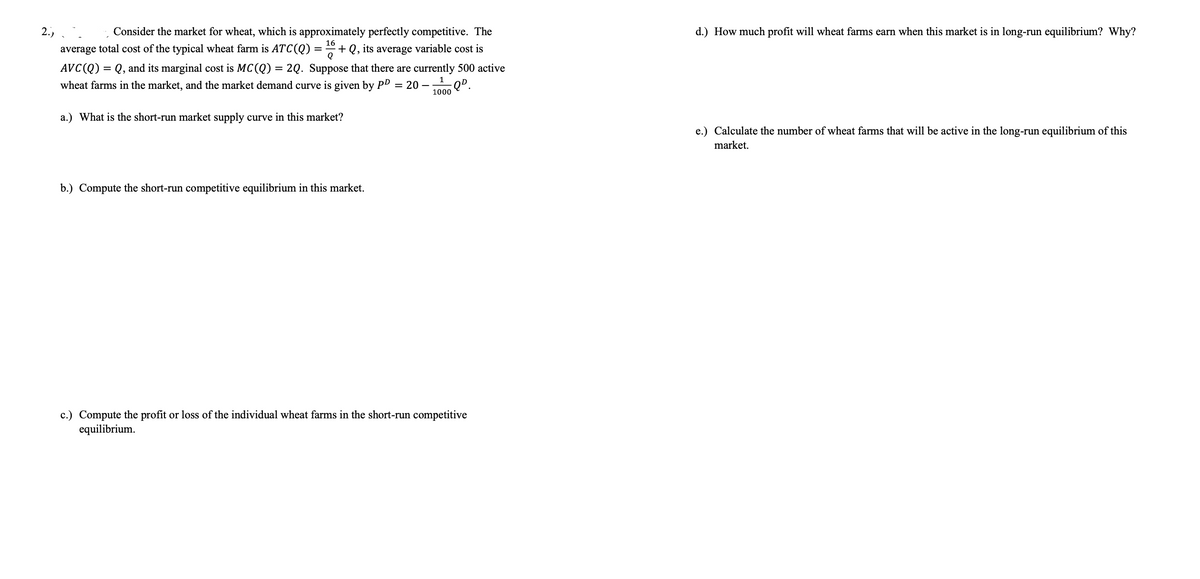Consider the market for wheat, which is approximately perfectly competitive. The average total cost of the typical wheat farm is ATC(Q) = 1+ Q, its average variable cost is AVC(Q) = Q, and its marginal cost is MC(Q) = 2Q. Suppose that there are currently 500 active given by p = 20 -L0 d.) How much profit will wheat farms earn when this market is in long-run equilibrium? Why? wheat farms in the market, and the market demand curve 1000 a.) What is the short-run market supply curve this market? e.) Calculate the number of wheat farms that will be active in the long-run equilibrium of this market. b.) Compute the short-run competitive equilibrium in this market. c.) Compute the profit or loss of the individual wheat farms in the short-run competitive equilibrium.
Consider the market for wheat, which is approximately perfectly competitive. The average total cost of the typical wheat farm is ATC(Q) = 1+ Q, its average variable cost is AVC(Q) = Q, and its marginal cost is MC(Q) = 2Q. Suppose that there are currently 500 active given by p = 20 -L0 d.) How much profit will wheat farms earn when this market is in long-run equilibrium? Why? wheat farms in the market, and the market demand curve 1000 a.) What is the short-run market supply curve this market? e.) Calculate the number of wheat farms that will be active in the long-run equilibrium of this market. b.) Compute the short-run competitive equilibrium in this market. c.) Compute the profit or loss of the individual wheat farms in the short-run competitive equilibrium.
Essentials of Economics (MindTap Course List)
8th Edition
ISBN:9781337091992
Author:N. Gregory Mankiw
Publisher:N. Gregory Mankiw
Chapter13: Firms In Competitive Markets
Section: Chapter Questions
Problem 8PA
Related questions
Question

Transcribed Image Text:2.)
Consider the market for wheat, which is approximately perfectly competitive. The
d.) How much profit will wheat farms earn when this market is in long-run equilibrium? Why?
16
average total cost of the typical wheat farm is ATC(Q) = + Q, its average variable cost is
AVC(Q) = Q, and its marginal cost is MC(Q) = 2Q. Suppose that there are currently 500 active
wheat farms in the market, and the market demand curve is given by PD = 20 –
%3D
1000
a.) What is the short-run market supply curve in this market?
e.) Calculate the number of wheat farms that will be active in the long-run equilibrium of this
market.
b.) Compute the short-run competitive equilibrium in this market.
c.) Compute the pro
equilibrium.
or loss of the individual wheat farms in the short-run competitive
Expert Solution
This question has been solved!
Explore an expertly crafted, step-by-step solution for a thorough understanding of key concepts.
This is a popular solution!
Trending now
This is a popular solution!
Step by step
Solved in 4 steps

Knowledge Booster
Learn more about
Need a deep-dive on the concept behind this application? Look no further. Learn more about this topic, economics and related others by exploring similar questions and additional content below.Recommended textbooks for you

Essentials of Economics (MindTap Course List)
Economics
ISBN:
9781337091992
Author:
N. Gregory Mankiw
Publisher:
Cengage Learning

Managerial Economics: Applications, Strategies an…
Economics
ISBN:
9781305506381
Author:
James R. McGuigan, R. Charles Moyer, Frederick H.deB. Harris
Publisher:
Cengage Learning

Principles of Economics, 7th Edition (MindTap Cou…
Economics
ISBN:
9781285165875
Author:
N. Gregory Mankiw
Publisher:
Cengage Learning

Essentials of Economics (MindTap Course List)
Economics
ISBN:
9781337091992
Author:
N. Gregory Mankiw
Publisher:
Cengage Learning

Managerial Economics: Applications, Strategies an…
Economics
ISBN:
9781305506381
Author:
James R. McGuigan, R. Charles Moyer, Frederick H.deB. Harris
Publisher:
Cengage Learning

Principles of Economics, 7th Edition (MindTap Cou…
Economics
ISBN:
9781285165875
Author:
N. Gregory Mankiw
Publisher:
Cengage Learning

Principles of Microeconomics (MindTap Course List)
Economics
ISBN:
9781305971493
Author:
N. Gregory Mankiw
Publisher:
Cengage Learning

Principles of Economics (MindTap Course List)
Economics
ISBN:
9781305585126
Author:
N. Gregory Mankiw
Publisher:
Cengage Learning

Principles of Microeconomics
Economics
ISBN:
9781305156050
Author:
N. Gregory Mankiw
Publisher:
Cengage Learning